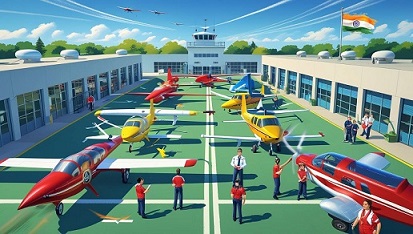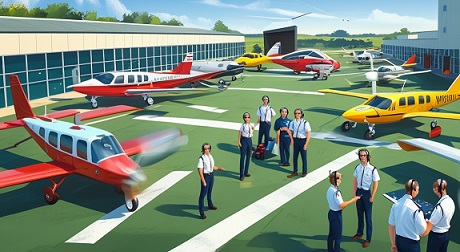Have you ever dreamed of soaring through the skies, commanding a powerful aircraft, and exploring the world from above? 🛫 For many aspiring pilots in India, this dream is within reach – but only with the right training and education. The journey to becoming a pilot is exhilarating, challenging, and life-changing, but it all starts with choosing the perfect flight school.
With the aviation industry in India experiencing rapid growth, the demand for skilled pilots has never been higher. However, not all flight schools are created equal. The quality of training, state-of-the-art facilities, and industry connections can make all the difference in launching a successful career in aviation. So, how do you navigate the complex landscape of flight schools in India to find the one that will set you on the path to success?
In this comprehensive guide, we’ll take you on a journey through the best flight schools in India, exploring everything from top-rated institutions to key factors in choosing the right school for you. We’ll dive into admission requirements, various training programs, and even tackle the important topic of costs. By the end, you’ll be equipped with all the information you need to make an informed decision and take that first step towards your dream career in the skies. Buckle up and prepare for takeoff as we explore the world of pilot training in India! ✈️

Top-Rated Flight Schools in India
A. Indira Gandhi Rashtriya Uran Akademi (IGRUA)
Located in Amethi, Uttar Pradesh, IGRUA is widely regarded as India’s premier flight school. Established in 1985, it offers state-of-the-art training facilities and a comprehensive curriculum for aspiring pilots.
Key features:
- Government-run institution
- Modern fleet of training aircraft
- Experienced instructors with international exposure
- High placement rate in major airlines
B. National Flying Training Institute (NFTI)
NFTI, situated in Gondia, Maharashtra, is a joint venture between CAE and the Airports Authority of India. It provides world-class pilot training using advanced simulation technology.
Notable aspects:
- Collaboration with global aviation leader CAE
- Multi-crew Pilot License (MPL) program
- Cutting-edge flight simulators
- Strong industry connections
C. Rajiv Gandhi Academy for Aviation Technology
Based in Thiruvananthapuram, Kerala, this academy offers various aviation courses, including commercial pilot training and aircraft maintenance engineering.
Highlights:
- Diverse range of aviation programs
- Well-equipped training facilities
- Affordable fee structure
- Beautiful coastal location
D. Bombay Flying Club
Founded in 1929, the Bombay Flying Club is India’s oldest aviation training institution. Located in Mumbai, it continues to be a popular choice for aspiring pilots.
Unique features:
- Rich historical legacy
- Prime location near Mumbai’s international airport
- Hands-on training approach
- Strong alumni network in the aviation industry
| Flight School | Location | Specialization |
|---|---|---|
| IGRUA | Amethi, UP | Comprehensive pilot training |
| NFTI | Gondia, MH | Advanced simulation-based training |
| Rajiv Gandhi Academy | Thiruvananthapuram, KE | Diverse aviation programs |
| Bombay Flying Club | Mumbai, MH | Traditional hands-on approach |
These top-rated flight schools in India offer excellent training programs and facilities, preparing students for successful careers in aviation. Each institution has its unique strengths, catering to different aspirations and preferences of aspiring pilots.
Key Factors in Choosing a Flight School
A. Accreditation and reputation
When selecting a flight school, accreditation and reputation are paramount. Look for schools approved by the Directorate General of Civil Aviation (DGCA) in India. A reputable flight school should have:
- DGCA certification
- Positive industry recognition
- Strong alumni network
- Transparent safety record
B. Fleet of training aircraft
The quality and variety of training aircraft significantly impact your learning experience. Consider:
| Aircraft Type | Advantages |
|---|---|
| Single-engine | Basic training, cost-effective |
| Multi-engine | Advanced skills, career preparation |
| Glass cockpit | Modern avionics experience |
Ensure the school maintains a well-maintained, diverse fleet.
C. Instructor qualifications
Experienced, qualified instructors are crucial for your success. Look for:
- Instructors with commercial pilot licenses
- Extensive flight hours
- Teaching certifications
- Ongoing professional development
D. Training curriculum
A comprehensive curriculum should cover:
- Ground school theory
- Practical flight training
- Simulator sessions
- Emergency procedures
- Navigation and communication skills
E. Job placement assistance
Career support can be invaluable. Seek schools offering:
- Industry partnerships
- Internship opportunities
- Resume building workshops
- Interview preparation
- Alumni networking events
By carefully evaluating these factors, you’ll be better equipped to choose a flight school that aligns with your goals and provides the best foundation for your aviation career. Next, we’ll explore the specific admission requirements for aspiring pilots in India.

Admission Requirements for Aspiring Pilots
A. Educational qualifications
To embark on a career as a pilot in India, aspiring aviators must meet specific educational requirements:
- Minimum qualification: 10+2 (Higher Secondary) with Physics and Mathematics as core subjects
- Preferred subjects: Physics, Mathematics, and English
- Academic performance: A minimum aggregate of 50% marks in 10+2
B. Medical fitness standards
Aspiring pilots must meet stringent medical fitness criteria to ensure they can safely operate aircraft:
| Class of Medical Certificate | Required for |
|---|---|
| Class I | Commercial Pilot License (CPL) |
| Class II | Private Pilot License (PPL) |
Key medical requirements include:
- Perfect eyesight (6/6 vision) or correctable to 6/6
- No color blindness
- Normal hearing
- Good physical and mental health
C. Age restrictions
Age plays a crucial role in pilot training and licensing:
- Minimum age for solo flight: 16 years
- Minimum age for Private Pilot License (PPL): 17 years
- Minimum age for Commercial Pilot License (CPL): 18 years
- Maximum age limit: Varies by airline, typically around 26-30 years for entry-level positions
D. Language proficiency
Effective communication is vital in aviation. Aspiring pilots must demonstrate:
- Fluency in English (spoken and written)
- ICAO English Language Proficiency Test: Minimum Level 4 (Operational)
With these requirements in mind, let’s explore the various types of pilot training programs available in India.
Types of Pilot Training Programs
Commercial Pilot License (CPL)
The Commercial Pilot License (CPL) is a crucial step for those aspiring to fly professionally. This program typically includes:
- Minimum 200 flight hours
- Advanced navigation and instrument flying
- Multi-engine aircraft operations
- Commercial aviation regulations
Private Pilot License (PPL)
The Private Pilot License is ideal for hobbyists or those starting their aviation journey:
- Minimum 40-50 flight hours
- Basic aircraft operations and navigation
- Solo flight training
- Night flying experience
Airline Transport Pilot License (ATPL)
The ATPL is the highest level of aircraft pilot certificate:
- Minimum 1500 flight hours
- Advanced theoretical knowledge
- Complex aircraft systems management
- Leadership and crew resource management
Type ratings and specializations
Pilots can further specialize with various type ratings:
| Type Rating | Description | Common Aircraft |
|---|---|---|
| Single-engine | For smaller aircraft | Cessna 172, Piper PA-28 |
| Multi-engine | For larger, multi-engine planes | Boeing 737, Airbus A320 |
| Helicopter | Rotary-wing aircraft | Bell 206, Robinson R44 |
Additional specializations include:
- Aerobatics
- Agricultural flying
- Search and rescue operations
With these diverse training programs, aspiring pilots can choose the path that best aligns with their career goals and interests in the aviation industry. Next, we’ll explore the cost considerations for flight training in India, which is an important factor in choosing the right program.
Cost Considerations for Flight Training in India
A. Tuition fees
Tuition fees for flight training in India can vary significantly depending on the institution and the program chosen. On average, aspiring pilots can expect to pay between ₹20-40 lakhs for a complete Commercial Pilot License (CPL) course. Here’s a breakdown of typical tuition fees across different flight schools:
| Flight School | Tuition Fee Range (in ₹) |
|---|---|
| Indira Gandhi Rashtriya Uran Akademi | 25-30 lakhs |
| Bombay Flying Club | 30-35 lakhs |
| Rajiv Gandhi Aviation Academy | 20-25 lakhs |
| Chimes Aviation Academy | 35-40 lakhs |
B. Flight hours and simulator costs
Flight hours and simulator training form a substantial part of the overall cost. Typically, students need to complete:
- 200 hours of flying time
- 40 hours of simulator training
The cost per flying hour ranges from ₹10,000 to ₹15,000, while simulator hours cost between ₹5,000 to ₹8,000 per hour.
C. Accommodation and living expenses
Additional costs to consider include:
- Accommodation: ₹8,000 – ₹15,000 per month
- Food and daily expenses: ₹6,000 – ₹10,000 per month
- Study materials and uniforms: ₹50,000 – ₹1,00,000 (one-time expense)
D. Financing options and scholarships
To manage these costs, aspiring pilots can explore:
- Education loans from banks (interest rates ranging from 7.5% to 14%)
- Government scholarships for SC/ST and economically backward students
- Merit-based scholarships offered by individual flight schools
- Part-time work opportunities to offset living expenses
Now that we’ve covered the financial aspects of flight training, let’s explore the career prospects that await trained pilots in India.
Career Prospects for Trained Pilots
A. Domestic airlines opportunities
The Indian aviation sector is experiencing rapid growth, creating numerous opportunities for trained pilots in domestic airlines. Major carriers like Air India, IndiGo, SpiceJet, and Vistara are expanding their fleets and routes, leading to increased demand for skilled pilots.
| Airline | Fleet Size | Projected Growth |
|---|---|---|
| IndiGo | 300+ | 25% annually |
| Air India | 130+ | 20% annually |
| SpiceJet | 100+ | 15% annually |
| Vistara | 50+ | 30% annually |
Newly trained pilots can expect:
- Entry-level positions as First Officers
- Competitive salaries and benefits
- Opportunities for career advancement to Captain roles
- Exposure to diverse routes and aircraft types
B. International aviation sector
Indian pilots are highly sought after in the global aviation industry due to their excellent training and English language proficiency. Many international airlines actively recruit Indian pilots, offering exciting career prospects abroad.
Key opportunities include:
- Middle Eastern carriers (Emirates, Etihad, Qatar Airways)
- Southeast Asian airlines (Singapore Airlines, AirAsia)
- European and North American airlines
C. Corporate and private jet piloting
The growing number of high-net-worth individuals and businesses in India has led to an increase in demand for corporate and private jet pilots. This niche sector offers:
- Luxurious working conditions
- Flexible schedules
- Higher pay compared to commercial airlines
- Opportunity to fly state-of-the-art aircraft
D. Government and military aviation roles
Trained pilots can also explore career options in government and military aviation. These roles offer unique challenges and opportunities for serving the nation.
Potential roles include:
- Indian Air Force pilot
- Coast Guard pilot
- Border Security Force pilot
- Police aviation units
With such diverse career prospects, aspiring pilots can look forward to a rewarding and dynamic future in aviation. The next section will delve into the essential factors to consider when selecting a flight school to kickstart your piloting career.
Conclusion
India’s aviation industry is soaring to new heights, and aspiring pilots have several excellent flight schools to choose from. From top-rated institutions to diverse training programs, these schools offer comprehensive education and hands-on experience to shape the future of aviation. When selecting a flight school, consider factors such as accreditation, facilities, instructor quality, and career support. Understanding admission requirements and various training programs will help you make an informed decision.
As you embark on your journey to become a pilot, carefully weigh the costs associated with flight training against the potential career prospects. With the growing demand for skilled pilots in India and abroad, investing in quality education at a reputable flight school can open doors to exciting opportunities in commercial aviation, private charters, and beyond. Take the first step towards your dream career by exploring the best flight schools India has to offer and prepare to soar to new heights in the aviation industry.
